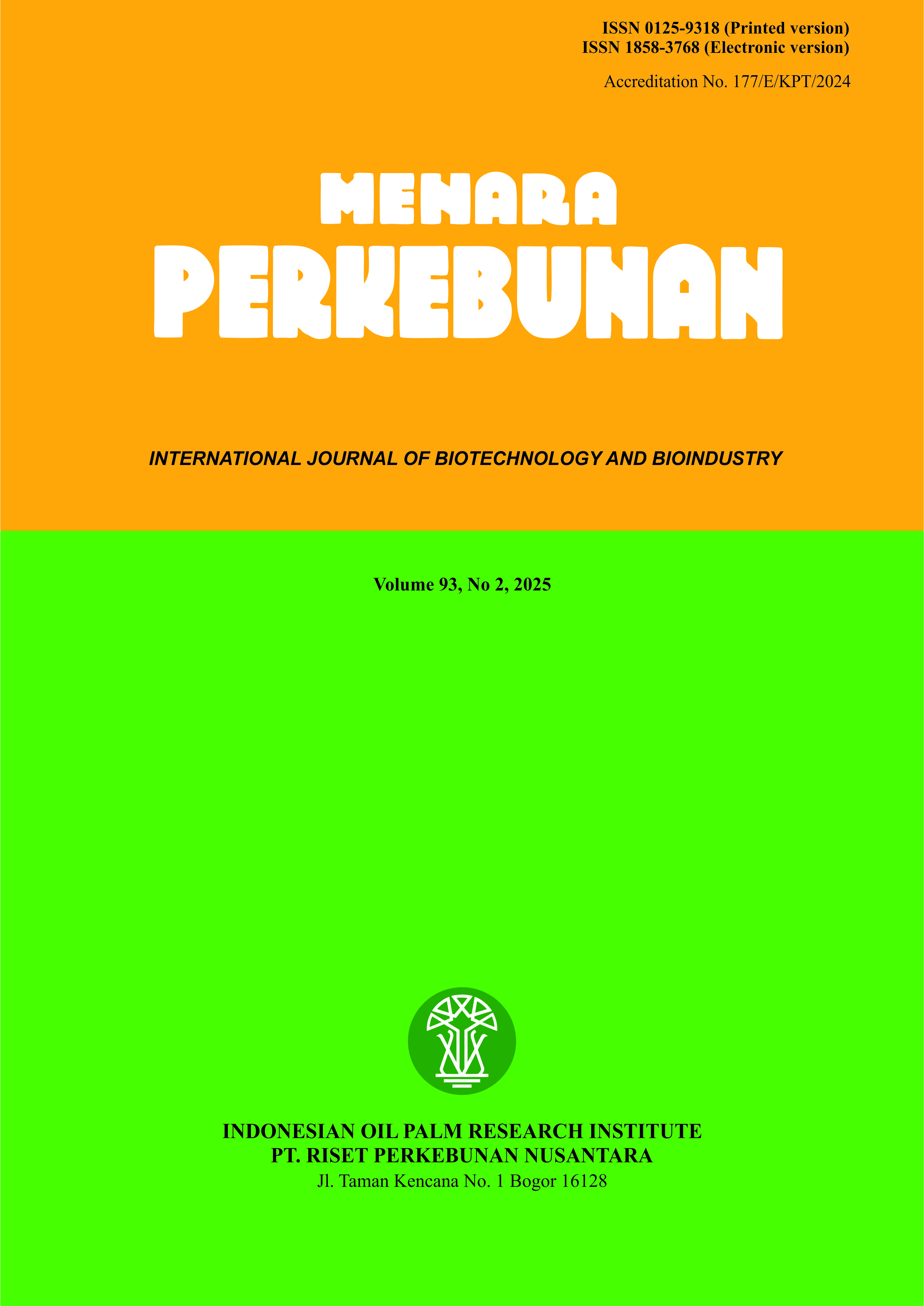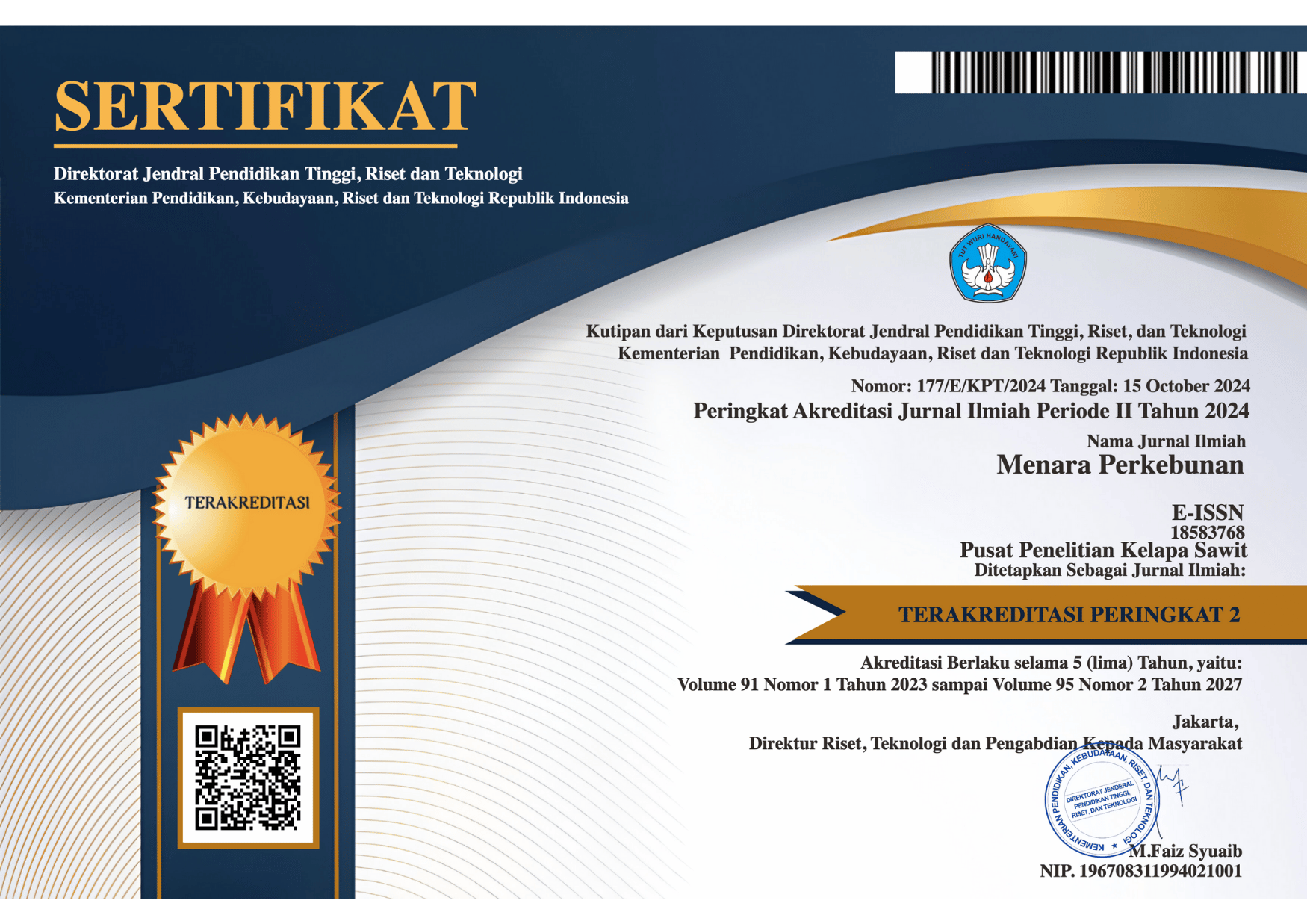Characterisation of novel acidic lipase of Corynebacterium nuruki PM2 from palm oil mill effluent for palm oil derivatisation
DOI:
https://doi.org/10.22302/iribb.jur.mp.v93i2.633Keywords:
biocatalysis, enzymatic, microbial lipase, transesterification, palm oil residueAbstract
The palm oil industry generates significant amounts of palm oil mill effluent (POME), which harbors diverse microbial communities with potential biotechnological applications. Yet, only a limited number of lipolytic bacteria have been isolated and studied. A limited nutrient medium selection has been previously demonstrated for isolating unique indigenous bacteria. This study aimed to isolate novel lipolytic bacteria from POME and characterize the lipase for potential palm oil derivatization. Corynebacterium nuruki PM2 was successfully isolated and identified. Distinct colony morphologies were observed on different agar media. Lipase from C. nuruki PM2 (LipCN) exhibited optimum activity at 40-60°C, pH 5.0-8.0, and with vegetable oil as substrate. The enzyme also showed the highest stability at a temperature between 30 °C and 40°C and at a pH of 7.0-8.0 after 30 minutes of incubation. The enzyme remained stable in methanol, isopropanol, and n-hexane. Metal ions such as Mn2+ and surfactants (e.g., Triton X-100, Tween-80, and Tween-20 significantly inhibit LipCN activity. Thin-layer chromatography identified 2-palmitoylglycerol in the hydrolyzed product of LipCN, suggesting sn-1,3 specific activity of the enzyme.
Downloads
References
Ali, S., Khan, S. A., Hamayun, M., & Lee, I. J. (2023). The recent advances in the utility of microbial lipases: a review. Microorganisms, 11, 150. https://doi.org/10.3390/microorganisms/ 11020510
Bajpai, I., Pal, P., & Bhasin, S. (2023). Highly efficient clay-based degumming aid for phosphorus removal from crude palm oil. International Journal of Oil Palm, 6(2), 13-24. https://doi.org/10.35876/ijop.v6i2.108
Chandra, P., Enespa, Singh, R., & Arora, P. K. (2020). Microbial lipases and their industrial applications: a comprehensive review. Microbial Cell Factories, 19, 169. https://doi.org/10.1186/ s12934-020-01428-8
Contesini, F. J., Davanço, M. G., Borin, G. P., Vanegas, K. G., Cirino, J. P. G., Melo, R. R. d., Mortensen, U. H., Hildén, K., Campos, D. R., & Carvalho, P. d. O. (2020). Advances in recombinant lipases: production, engineering, immobilization, and application in the pharmaceutical industry. Catalysts, 10(9), 1032. https://doi.org/10.3390/catal10091032.
Duan, X., Xiang, M., Wang, L., Yan, Q., Yang, S., & Jiang, Z. (2019). Biochemical characterization of a novel lipase from Malbranchea cinnamomea suitable for production of lipolyzed milkfat flavor and biodegradation of phthalate esters. Food Chemistry, 297, 124925. https://doi.org/10.1016/j.foodchem.2019.05.199
Fatima, S., Faryad, A., Ataa, A., Joyia, F. A., & Parvaiz, A. (2019). Microbial lipase production: A deep insight into the recent advances of lipase production and purification techniques. Biotechnology & Applied Biochemistry. https://doi.org/10.1002/bab.2019
Hasibuan, H. A., Sitanggang, A. B., Andarwulan, N., & Hariyadi, P. (2021). Enzymatic synthesis of human milk fat substitute: a review on technological approaches. Food Technology Biotechnology, 59(4), 475–495. https://doi.org/ 10.17113/ftb.59.04.21.7205
Ibiyemi, F. M. & Julius, O. O. (2022). Assessment of lipolytic activities of bacteria isolated from palm oil processing cottage industries in Ekiti State, Nigeria. World Journal of Advanced Research and Reviews, 15(1), 225–232. https://doi.org/10.30574/wjarr.2022.15.1.0696
Kamal, M. Z., Yedavalli, P., Deshmukh, M. V., & Rao, N. M. (2013). Lipase in aqueous-polar organic solvent: activity, structure, and stability. Protein Science, 22, 904-915. https://doi.org/ 10.1002/pro.2271
Karno, R., Arisoesilaningsih, E., Mustafa, I., & Siswanto, D. (2024). The diversity of indigenous and potential bacteria as bioremediators of palm oil mill secondary effluent (POMSE) by metagenomics assessment. Biodiversitas, 25(3), 1194-1200. https://doi.org/10.13057/biodiv/d25 0335
Kotogán, A., Zambrano, C., Kecskeméti, A., Varga, M., Szekeres, A., Papp, T., Vágvölgyi, C., & Takó, M. (2018). An organic solvent-tolerant lipase with both hydrolytic & synthetic activities from the oleaginous fungus Mortierella echinosphaera. International Journal of Molecular Sciences, 19(4), 1129. https://doi.org/ 10.3390/ijms19041129
Li, Y., Li, G., Sun, H., & Chen, Y. (2021). Characterization of a novel sn-1,3 lipase from Ricinus communis L. suitable for the production of oleic acid‑palmitic acid‑glycerol oleate. Nature, 11, 6913.
Liu, T., Wang, Y., Luo, X., Li, J., Reed, S. A., Xiao, H., Young, T. S., & Schultz, P. G. (2016). Enhancing protein stability with extended disulfide bonds. Proceedings of the National Academy of Sciences, 113(21), 5910–5915. https://doi.org/10.1073/pnas.1605363113
Ma, Q., Sun, X., Gong, S., & Zhang, J. (2010). Screening and identification of a highly lipolytic bacterial strain from barbecue sites in Hainan and characterization of its lipase. Annals of Microbiology, 60(3), 429–437. https://doi.org/ 10.1007/s13213-010-0060-1
Marchesi, J. R., Sato, T., Weightman, A. J., Martin, T. A., Fry, J. C., Hiom, S. J., & Wade, W. G. (1998). Design and evaluation of useful Bacterium-Specific PCR primers that amplify genes coding for bacterial 16S RRNA. Applied and Environmental Microbiology, 64(2), 795–799. https://doi.org/10.1128/aem.64.2.795-799. 1998
Marisch, K., Bayer, K., Cserjan-Puschmann, M., Luchner, M., & Striedner, G. (2013). Evaluation of three industrial Escherichia coli strains in fed-batch cultivations during high-level SOD protein production. Microbial Cell Factories, 12(1), 58. https://doi.org/10.1186/1475-2859-12-58
Narihiro, T., Suzuki, A., Yoshimune, K., Hori, T., Hoshino, T., Yumoto, I., Yokota, A., Kimura, N., & Kamagata, Y. (2014). The Combination of functional metagenomics and an oil-fed enrichment strategy revealed the phylogenetic diversity of lipolytic bacteria overlooked by the cultivation-based method. Microbes & Environment, 29(2), 154-161. https://doi.org/ 10.1128/AEM.64.2.795-799.1998
Nwuche, C. O. & Ogbonna, J. C. (2011). Isolation of lipase-producing fungi from palm oil mill effluent (POME) dump sites at Nsukka. Brazilian Archives of Biology and Technology, 54(1), 113–116. https://doi.org/10.1590/S1516-89132011000100015
Okwute, O. L., Stephen, E., & Anyanwu, P. I. (2015). Biodegradation of palm oil mill effluent (POME) and lipase activity by Pseudomonas aeruginosa, Bacillus subtilis and Candida albicans. Microbiology Research Journal International, 9(5), 1–10. https://doi.org/ 10.9734/BMRJ/2015/18601
Pablo, G., Hammons, A., Bradley, S., & Fulton, J. E. (1974). Characteristics of the extracellular lipases from Corynebacterium acnes and Staphylococcus epidemidis. The Journal of Investigative Dermatology, 63, 231-238.
Periadnadi, P., Nurmiati, N., Siregar, F. W., & Edelwis, T. W. (2024). Exploration and characterization of lipid-degrading bacteria from palm oil mill effluent. Global Journal of Environmental Science & Management, 20(4), 1615-1628. https://doi.org/10.22034/gjesm.202 4.04.08
Pham, V. H. T., Kim, J., Chang, S., & Chung, W. (2021). Investigation of lipolytic-secreting bacteria from an artificial polluted soil using a modified culture method and optimization of their lipase production. Microorganism, 9, 2590. https://doi.org/10.3390/microorganisms9122590
Putra, L., Natadiputri, G., Meryandini, A., Suwanto, A. (2019). Isolation, cloning and co-expression of lipase and foldase genes of Burkholderia territorii GP3 from Mount Papandayan soil. Journal of Microbiology & Biotechnology, 29(6), 944-951. https://doi.org/10.4014/jmb. 1812.12013
Salas, J. J., Bootello, M. A., Piispa, E., Hornyak, L., Venegas-Caleron, M., Martinez-Force, E., & Garces, R. (2024). The effect of enzymatic interesterification on the high oleic-high stearic sunflower oil fractionation and the physico-chemical properties of stearins. Food Science & Technology, 184(2023), 115042. https://doi.org/ 10.1016/j.lwt.2023.115042
Shi, J., Chen, X., Zhong, M., Wang, L., Zhao, Z., & He, Q. (2024). Screening and characterization of a novel cold-adapted and organic solvent-tolerant lipase from psychrotrophic Janthinobacterium sp. strain YH1. Frontiers in Microbiology, 15, 11505249. https://doi.org/ 10.3389/fmicb.2024.11505249
Shin, N. R., Jung, M. J., Kim, M. S., Roh, S. W., Nam, Y. D., & Bae, J. W. (2010). Corynebacterium nuruki sp. nov., isolated from an alcohol fermentation starter. International Journal of Systematic and Evolutionary Microbiology, 60(11), 2587–2592. https:// doi.org/10.1099/ijs.0.027763-0
Skjold Jørgensen, J., Bhatia, V. K., Vind, J., Svendsen, A., Bjerrum, M. J., & Farrens, D. (2015). The enzymatic activity of lipases correlates with polarity induced conformational changes: A Trp induced quenching fluorescence study. Biochemistry, 54(27), 4186–4196. https:// doi.org/10.1021/ACS.BIOCHEM.5B00328
Suwanno, S., Rakkan, T., Yunu, T., Paichid, N., Kimtun, P., Prasertsan, P., & Sangkharak, K. (2017). The production of biodiesel using residual oil from palm oil mill effluent and crude lipase from oil palm fruit as an alternative substrate and catalyst. Fuel, 195, 82-87. http://dx.doi.org/10.1016/j.fuel.2017.01.049
Wang, S., Meng, X., Zhou, H., Liu, Y., Secundo, F., & Liu, Y. (2016). Enzyme stability and activity in non-aqueous reaction systems: a mini review. Catalysts, 6(2), 32. https://doi.org/ 10.3390/catal6020032
Willerding, A. L., Oliveira, L. A., Moreira, F. W., Germano, M. G., & Chagas Jr., A. F. (2011). Lipase activity among bacteria isolated from Amazonian soils. Enzyme Research, 720194. https://doi.org/10.4061/2011/720194
Xing, S., Zhu, R., Cheng, K., Cai, Y., Hu, Y., Li, C., Zeng, X., Zhu, Q., & He, L. (2021). Gene expression, biochemical characterization of a sn-1,3 extracellular lipase from Aspergillus niger GZUF36 and its model-structure analysis. Frontiers in Microbiology, 13, 633489. https://doi.org/10.3389/fmicb.2021.633489
Xing, S., Long, J., Xie, W., Luo, C., He, L., Li, C., & Zeng, X. (2024). Characterization of a recombinant Aspergillus niger GZUF36 lipase immobilized by an ionic liquid modification strategy. Applied Microbiology and Biotechnology, 108, 233. https://doi.org/ 10.1007/s00253-024-13071-z
Zhang, M., Xu, B., Zhao, D., Shen, M., Li, M., Liu, D., & Liu, L. (2024). Production of margarine fat containing medium- and long-chain triacylglycerols by enzymatic interesterification of peony seed oil, palm stearin, and coconut oil blends. Foods. 13(9), 1405. https://doi.org/ 10.3390/foods13091405
Downloads
Submitted
Accepted
Published
How to Cite
Issue
Section
License
Copyright (c) 2025 Ludwinardo Putra, Irma Kresnawaty, Imron Riyadi

This work is licensed under a Creative Commons Attribution 4.0 International License.
Authors retain copyright and grant the journal right of first publication with the work simultaneously licensed under a Creative Commons Attribution License that allows others to share the work with an acknowledgement of the work's authorship and initial publication in this journal.













